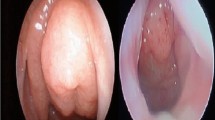Abstract
Microdebrider adenoidectomy and Coblation adenoidectomy are the two new techniques available for adenoidectomy these days. The advantages of endoscopic power assisted adenoidectomy over cold steel adenoidectomy has been well established in the literature. As adenoidectomy is one of the most common paediatric surgical procedure there is always a concern to improve the outcomes and make postoperative experience more pleasant for the paediatric population. Cost difference between a coblator wand and microdebrider blade is always a confounding factor in decision making. The present study was conducted to compare both the techniques of adenoidectomy in terms of certain intraoperative and post operative parameters. The present study was a prospective randomized single blind study conducted in a university hospital on 140 subjects. The patients diagnosed with chronic adenoiditis grade 3–4 were randomly allocated in two groups after following the exclusion and inclusion criteria. the adenoidectomy in two groups; Microdebrider group and Coblation group were compared in terms of intraoperative time, post operative pain score; intraoperative bleeding, surgical field and some common complications. The data was analysed for significance by various statistical tests. The average adenoid size operated in both groups was Grade 3. The intraoperative time taken to complete the procedure in group A was 12.78 ± 3.8 min and in group B was 22 ± 3.3 min with p value < 0.05. There was statistically significant difference in grade of Intraoperative Bleeding in both groups with mean grade of intraoperative bleeding being 1.4 ± 1.04 in group B and 3.5 ± 0.9 in Group A. The surgical field was poor to average in 33 cases (n = 70) in group A as compared to only 1 case (n = 70) in group B; the difference being statistically significant. The average post-operative pain score was 2.69 ± 0.99 and 1.17 ± 1.1 after post-operatively 24 h and 72 h respectively in group B; 7.14 ± 0.99 and 4.08 ± 1.42 respectively in group A. The p value for the same was < 0.05. However there was no statistically significant difference between two groups in terms of any complications or completeness of removal. Though both the techniques are highly efficacious in adenoid removal and low complication rate in our study but still more studies with large sample size are encouraged to validate these results and establish the comparative efficacy of both the techniques in terms of the intraoperative parameters as well as post-operative recovery along with recurrence rates.



Similar content being viewed by others
References
Cullen KA, Hall MJ, Golosinskiy A (2006) Ambulatory surgery in the United States. Natl Health Stat Report 2009:1–25
Wilson YL, Merer DM, Moscatello AL (2009) Comparison of three common tonsillectomy techniques: a prospective randomized, double-blinded clinical study. Laryngoscope 119:162–170
Koltai PJ, Chan J, Younes A (2002) Power-assisted adenoidectomy: total and partial resection. Laryngoscope 112(suppl 100):29–31
Reed J, Sridhara S, Brietzke SE (2009) Electrocautery adenoidectomy outcomes: a meta-analysis. Otolaryngol Head Neck Surg 140:148–153
Clemens J, McMurray JS, Willging JP (1998) Electrocautery versus curette adenoidectomy: comparison of postoperative results. Int J Pediatr Otorhinolaryngol 43:115–122
Kim JW, Kim HJ, Lee WH, Kim DK, Kim SW, Kim YH et al (2015) Comparative study for efficacy and safety of adenoidectomy according to the surgical method: a prospective multicenter study. PLoS ONE 10(8):e0135304
Cote CJ, Lerman J, Tordes ID (2018) A practice of anaesthesia for infants and children, 6th edn. Elsevier, Amsterdam
Drendel AL, Kelly BT, Ali S (2011) Pain assessment for children: overcoming challenges and optimizing care. Pediatr Emerg Care 27(8):773–781
Agrawal V, Agarwal PK, Agrawal A (2016) Defning the surgical limits of adenoidectomy so as to prevent recurrence of adenoids. Indian J Otolaryngol Head Neck Surg 68(2):131–134
Benninger M, Walner D (2007) Coblation: improving outcomes for children following adenotonsillectomy. Clin Cornerstone 9(Suppl 1):S13–S23. https://doi.org/10.1016/S1098-3597(07)80005-6
Ghosh S, Roper A (2005) Adenoidectomy with the coblator: a logical extension of radiofrequency tonsillectomy. J Laryngol Otol 119(05):398–399
Plant RL (2002) Radiofrequency treatment of tonsillar hypertrophy. Laryngoscope 112:20–22
Di Rienzo Businco L, Angelone AM, Mattei A, Ventura L, Lauriello M (2012) Paediatric adenoidectomy: endoscopic coblation technique compared to cold curettage. Acta Otorhinolaryngol Ital 32:124–129
Özkiriş M, Karaçavuş S, Kapusuz Z, Saydam L (2013) Comparison of two different adenoidectomy techniques with special emphasize on postoperative nasal mucociliary clearance rates: coblation technique vs. cold curettage. Int J Pediatr Otorhinolaryngol 77:389–393
Belloso A, Chidambaram A, Morar P, Timms MS (2003) Coblation tonsillectomy versus dissection tonsillectomy: postoperative hemorrhage. Laryngoscope 113:2010–2013
Wilson CA, Sommerfield D, Drake-Brockman TF, Bieberstein L, Ramgolam A, Ungern-Sternberg BS (2006) Pain after discharge following head and neck surgery in children. Paediatr Anaesth 26:992–1001
Acknowledgements
Special Acknowledgement to Guru Ram Das University our deemed university for partial funding of this study.
Author information
Authors and Affiliations
Corresponding author
Ethics declarations
Conflict of interest
The authors declare that they have no conflict of interest.
Ethical approval
Before starting the study ethical clearance was taken from the institutional ethical committee as per declaration of Helsinki.
Informed consent
Informed consent was duly taken from patients.
Additional information
Publisher's Note
Springer Nature remains neutral with regard to jurisdictional claims in published maps and institutional affiliations.
Rights and permissions
About this article
Cite this article
Singh, J., Bhardwaj, B. The Comparison between Microdebrider Assisted Adenoidectomy and Coblation Adenoidectomy: Analyzing the Intraoperative Parameters and Post-operative Recovery. Indian J Otolaryngol Head Neck Surg 72, 59–65 (2020). https://doi.org/10.1007/s12070-019-01736-5
Received:
Accepted:
Published:
Issue Date:
DOI: https://doi.org/10.1007/s12070-019-01736-5




